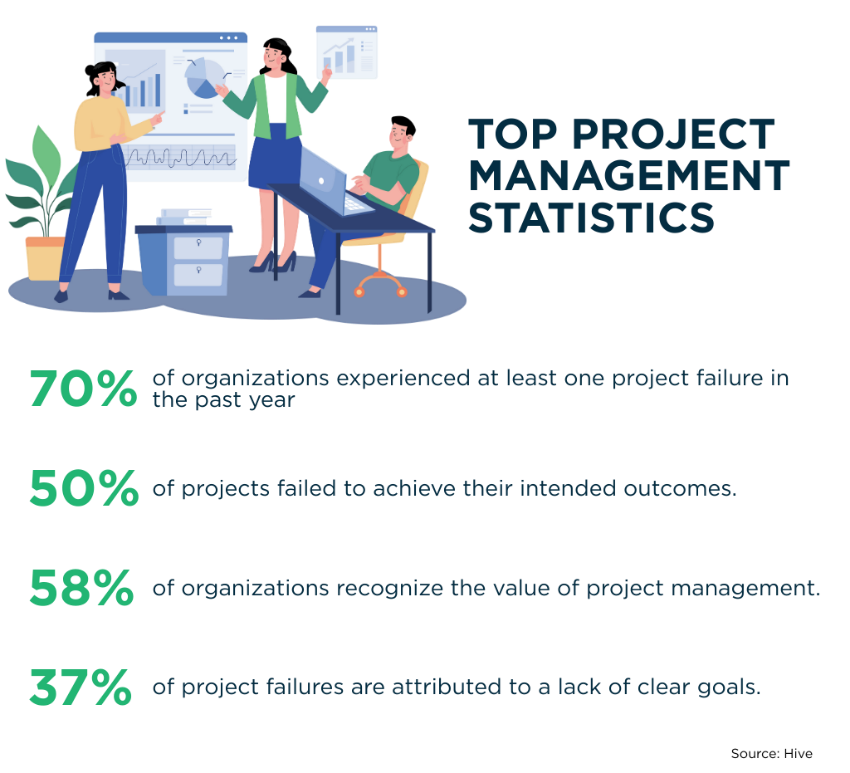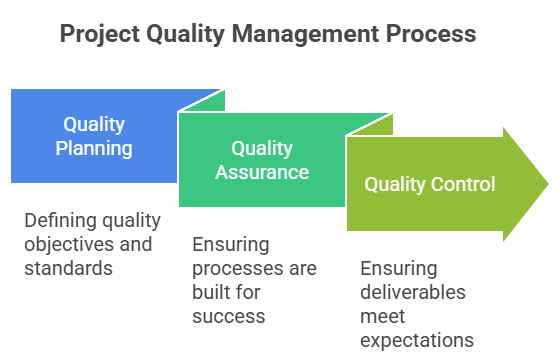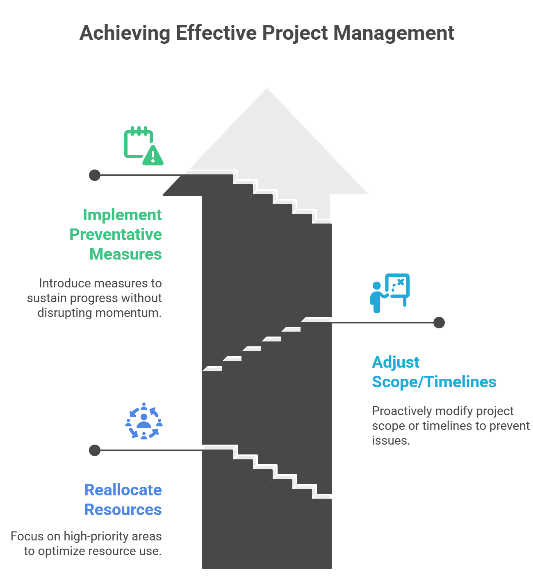
Quick Summary: Managing project quality today is about delivering consistent, high-value outcomes — not just meeting checklists. With 12% of resources lost to poor execution and over half of organizations lacking real-time KPI tracking, the risks are real. The answer? Embedding AI-powered predictive intelligence across every phase of quality management to drive proactive, insight-led decisions.
Why this matters: Quality management is no longer optional — it directly impacts trust, profit, and delivery timelines. In a high-pressure, fast-delivery project environment, managing project quality is no longer a background function — it is a defining factor in business competitiveness. The reality is sobering:
- 12% of resources are wasted due to poor project execution
- Only 43% of organizations deliver projects within budget
- 54% fail to track KPIs in real time
These numbers highlight a critical fact: without proactive, insight-led quality management, projects risk more than budget overruns — they risk client trust, market positioning, and long-term profitability. This article discusses the challenges, techniques, and strategic gains of turning quality into a competitive edge.
The Real Cost of Poor Project Execution
Every missed quality checkpoint isn’t just a minor oversight — it’s a compounding liability. Rework, delays, and budget overruns are the visible symptoms. But the deeper damage lies in depleted stakeholder trust and project team morale. In project-driven organizations, these costs escalate rapidly. Stakeholders aren’t looking for task completion — they demand measurable outcomes, strategic impact, and business value. Anything less is a missed opportunity.
_________________________________________________________________________________________________________________________
"The adoption of PSA, CRM and ERP solutions has grown, yet the lack of integration across platforms remains a barrier to achieving the real-time visibility necessary for proactive decision-making."
— SPI 2025 Professional Services Maturity Benchmark Report
_________________________________________________________________________________________________________________________
How Managing Project Quality Impacts Stakeholder Trust and Profitability

When managing project quality is treated as a strategic discipline rather than a compliance task, the benefits compound. Proactive quality management means:
• Fewer surprises in delivery timelines and costs
• Greater stakeholder confidence through transparent project progress tracking
• Stronger client retention due to consistent, high-value results
This understanding leads directly to how managing project quality works in practice — through a combination of planning, assurance, and control that ensures excellence at every stage.
When avoiding overruns and missed expectations is the goal, insight-led execution is where it begins. Start the conversation — explore how predictive intelligence can reshape your next project.
How You Can Project Quality Managed Effectively? 
Managing project quality is not a one-time event; it’s a continuous, integrated discipline anchored in three pillars: Quality Planning, Quality Assurance, and Quality Control. Together, they ensure deliverables consistently meet or exceed expectations while staying aligned with project goals and stakeholder priorities.
Quality Planning: Defining Standards and Stakeholder Alignment
The strongest projects begin with a clear blueprint. That means:
• Defining measurable quality objectives in collaboration with stakeholders
• Using predictive analytics to anticipate potential risks and adapt standards accordingly
• Maintaining transparency through real-time communication channels
Quality Assurance: Embedding Process Excellence in Managing Project Quality
Quality assurance focuses on making sure processes themselves are built for success:
• Regular audits to validate adherence to standards
• AI-driven monitoring for instant deviation detection
• Mining historical project data to eliminate recurring process inefficiencies
Quality Control: Ensuring Deliverables Meet or Exceed Expectations
The final safeguard before delivery includes:
• Rigorous inspections and peer reviews
• Automated quality checks for speed and precision
• Real-time KPI dashboards to quickly identify gaps
This section reflects established PMBOK® principles, reinforced by modern AI-enabled approaches proven in enterprise-scale project environments, aligning theoretical best practices with field-tested execution.
To see where your project stands right now, you need more than a gut check. Get instant clarity with a TrueProject SnapShot.
What Are the Biggest Challenges in Project Quality Management?
Even experienced teams encounter friction in managing project quality, especially in complex, multi-vendor or fast-moving environments. The most common challenges include:
• Unclear quality standards that create subjective interpretations
• Resource limitations in time, budget, or skilled personnel
• Misaligned stakeholder expectations that derail priorities
• Scope changes disrupting established quality controls
Where Predictive Intelligence Changes the Game:
• Automated compliance tracking enforces standards consistently
• Predictive risk models show how changes will affect quality before implementation
• Centralized quality data reduces miscommunication and ensures one source of truth
• Resource optimization algorithms allocate skills more effectively
These recommendations combine predictive AI capabilities validated in enterprise-grade deployments with proven quality management frameworks, delivering a balance of innovation and reliability grounded in practical experience.
Don’t wait for delivery gaps to surface. Kick off your QuickStart with TrueProject and embed proactive quality from day one
What works today: How to build sustainable quality into fast-paced, tech-driven delivery environments.
In a world of interconnected systems, remote teams, and rapid delivery cycles, managing project quality requires more than reactive checks. It’s about embedding quality principles into every decision, every sprint, and every deliverable — using technology not to replace human expertise, but to amplify it.
Setting Measurable Quality Objectives Linked to Project Goals
The most successful projects define quality not in vague terms but in quantifiable, outcome-focused targets. AI-assisted benchmarking ensures these targets are realistic yet progressive, enabling teams to continuously push performance without jeopardizing stability.
Example: Rather than saying “ensure user satisfaction,” define “achieve >92% satisfaction rating post-deployment” — then track it using predictive models.
Leveraging Predictive Analytics to Anticipate Quality Issues
Traditional reviews often uncover project problems only after deadlines have slipped. Predictive analytics reverses this logic — spotting risk patterns in advance so leaders can:
• Reallocate resources to high-priority areas
• Adjust scope or timelines before issues escalate
• Implement preventative measures without disrupting momentum
This shift toward early visibility is what turns quality management into a strategic shield, not a reactive fix.
Ensuring Clear Ownership and Accountability in Managing Project Quality
When responsibilities are ambiguous, quality becomes everyone’s job — and no one’s priority. Assigning explicit ownership, tracked through AI-enabled task monitoring, ensures each stage has a champion safeguarding standards.
Best practice: Use a RACI matrix with automated task alerts to ensure alignment, accountability, and follow-through across distributed teams.
These best practices merge lessons from enterprise-level delivery, PMI-aligned quality frameworks, and the proven impact of predictive analytics in SaaS environments, offering both theoretical grounding and practical application.
Seeing quality issues before they surface is a competitive edge you can’t ignore. Experience how it works — book your TrueProject demo.
Business Benefits of Managing Project Quality as a Strategic Advantage 
Quality management is now a revenue enabler and trust multiplier. Managing project quality is no longer about defect prevention — it’s about unlocking strategic value acrossthe enterprise. When treated as a growth driver, quality management generates compounding benefits that ripple across delivery teams, client relationships, and financial performance.
- Improved Customer Satisfaction and Loyalty
Consistent quality builds confidence. With AI-driven customization and predictive adjustments, deliverables not only meet expectations — they often exceed them, creating moments of value that strengthen client relationships over the long term.
According to PwC, 32% of customers will leave a brand they love after just one bad experience. Consistency is everything. - Enhanced Productivity, Cost Savings, and Profitability
Streamlined quality processes reduce costly rework, enabling teams to redirect resources toward innovation and value creation. The result is:
• Faster turnaround times
• Lower operational waste
• Healthier profit margins
Strengthened Stakeholder Confidence and Project Predictability. Transparency is a trust accelerator. Real-time data analytics dashboards keep stakeholders informed and engaged, fostering a collaborative environment where risks are addressed proactively — not reactively.
This next section highlights real-world use cases from organizations using predictive intelligence in quality management, backed by performance data from industry research.
Techniques for Monitoring and Managing Project Quality with AI Integration
Monitoring is where quality assurance meets real-world execution. Done right, it closes the loop between planning and performance — ensuring that high-level strategies are translated into on-the-ground outcomes. Blending traditional techniques with AI-enabled insight transforms monitoring from a compliance step into a continuous strategic advantage.
- Quality Audits and Continuous Improvement Frameworks
Regular audits validate adherence to standards. When augmented with AI, they become diagnostic tools — revealing patterns invisible to human reviewers and enabling data-driven improvements that stick.Frameworks such as Six Sigma and Kaizen become even more effective when supported by predictive models that highlight high-risk areas and recurring issues. - Using Real-Time KPI Tracking to Maintain Project Quality Standards
Predictive KPI monitoring does more than highlight performance dips — it forecasts them. This foresight enables targeted interventions before they snowball into delivery issues. Teams using AI-based KPI tracking reduce delay-related costs by 25% on average, according to internal data from enterprise SaaS implementations. - Automating Quality Checks for Faster, More Accurate Insights
Automation doesn’t replace quality control — it enhances it at scale. AI-powered checks operate continuously in the background, flagging anomalies, accelerating detection, and freeing human experts to focus on strategy. AI detects deviations and suggests likely causes and corrective paths, speeding up resolution and boosting confidence.
These techniques are drawn from established quality methodologies such as Six Sigma and Kaizen, elevated with modern AI capabilities validated in enterprise SaaS deployments.
Quality shouldn’t be an afterthought — it should be the standard.Let TrueProject help you raise the bar — schedule your discussion.
__________________________________________________________________________________________________________________________
“More than 7 out of 10 organizations believe that successful AI implementation can deliver competitive advantage, while almost 6 out of 10 firms believe that AI investments can expand service offerings."
— Deltek’s 2024 Clarity Study for Professional Services
_________________________________________________________________________________________________________________________
Conclusion: The Future of Managing Project Quality with Predictive Intelligence
The pace of business is accelerating. Project environments are more complex, client expectations higher, and competition fiercer. In this reality, managing project quality is no longer a back-office control — it’s a boardroom priority. From fixing defects to preventing them — at scale, in real time, with confidence.
Predictive intelligence changes the playbook.By combining real-time analytics, historical trend analysis, and AI-led forecasting, quality management evolves from detecting issues to anticipating them. It’s a shift from:
- “How do we fix this?”
- “How do we prevent this from happening?”
This evolution protects timelines, safeguards budgets, and strengthens client confidence.
This is where TrueProject, a KPI-based predictive project management SaaS solution, delivers unmatched project value. It’s not a monitoring tool — it’s an intelligence layer woven into your project management systems. From automated stakeholder sentiment analysis and real-time KPI dashboards to predictive alerts and actionable recommendations, TrueProject strengthens delivery quality by:
• Providing phase-by-phase QA reviews benchmarked against best practices
• Enabling early detection of risks and delivery gaps before they escalate
• Supporting process alignment through real-time insights and stakeholder feedback
Executives gain the certainty that every client touchpoint delivers confidence, not guesswork. Teams move with direction, not doubt. And quality? It stops being a checkpoint — and becomes a built-in, measurable force driving every decision.
TrueProject delivers results that are proven and measurable.
If you’re ready to move from reactive problem-solving to proactive excellence, it starts with one step. Schedule your TrueProject demo today.
FAQs
Q1: What is managing project quality in project management?
Managing project quality means defining standards, ensuring processes follow them, and validating outcomes — all to meet stakeholder expectations. It involves quality planning, assurance, and control.
Q2: Why is managing project quality important?
It reduces rework, protects timelines, and builds client trust — directly impacting profitability and long-term success.
Q3: How does AI improve project quality management?
AI enables early risk detection, automates quality reviews, monitors KPIs in real time, and turns data into proactive decisions — helping teams stay ahead of issues before they escalate.
Q4: What are the biggest challenges in managing project quality?
Common challenges include unclear standards, fragmented tools, resource constraints, and misaligned expectations — all of which predictive intelligence helps address.
Q5: What’s the difference between quality assurance and quality control?
Quality assurance focuses on improving the processes to prevent defects. Quality control focuses on checking deliverables to detect and fix issues before delivery.






